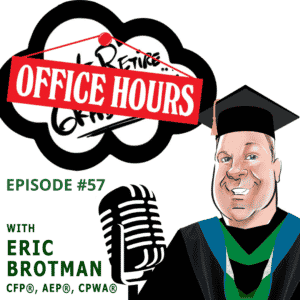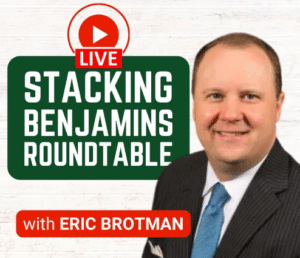In today’s Office Hours, Eric answers April’s question: “Why do some advisors say that taking 5% or more of your retirement nestegg out every year is dangerous?”
Determining a reasonable withdrawal rate depends on factors including your asset level, retirement timeline, and age. Eric explains three different asset structuring strategies that can help you avoid outliving your money.
Have a question? Post it in the comments, tweet it to us at @BrotmanPlanning, or post it on our Facebook and it may be used in a future episode of Office Hours!
[
[00:00:00] Eric Brotman: This is Eric Brotman, the host of Don’t Retire… Graduate!: The podcast that teaches you how to advance into retirement rather than retreating. Welcome to office hours where we answer questions from listeners like you about personal finance, retirement readiness, and more. We received a question from April who asked, “why do some advisors say that taking 5% or more of your retirement nest egg out every year is dangerous?”
And April, that is an interesting question to me because I don’t know too many advisors who wouldn’t say that. I think you have to determine a timeframe that is reasonable for accessing your retirement nest egg. And so here’s what I mean. If you consider your retirement, let’s consider your nest egg. It doesn’t matter what the amount is, but let’s just say that you have X dollars. Consider that like an orchard it’s full of trees and those trees are bearing fruit every year. Whether it’s interest or dividends or appreciation, or however you determine that fruit’s gonna be in your portfolio. You can, as long as you maintain that orchard, you maintain the trees. You can pick fruit every year for the rest of your life. If you start withdraw more money from your retirement portfolio than it’s bearing in terms of either income or appreciation, then you’re not just picking the fruit in your orchard.
You’re also chopping off branches of your trees or cutting down trees entire. and while you can do that and you can pay the bills for a year, when you start chopping off branches, or you start chopping down trees, you will have less fruit next year and less the year after that. And the year after that, and the year after that.
So if you’re pulling out, you know, there there’s always been this sort of rule of thumb that 4% is a safe withdrawal rate. And I contend that there’s no such thing as a safe withdrawal rate, uh, and that you really have to look at this a lot of different ways, but in general, if you can have a withdrawal rate in the 3% neighborhood, which means for every million dollars that you’ve amassed, you pull out $30,000 a year. It’s 3%. At that level, I’m not gonna say you can be assured you’re not going to run outta money, but the odds are in your favor that you will not only continue to bear fruit and continue to, to have money to live on, but you’re also likely to be growing new trees because the portfolio over time, ideally, should be positioned not only to produce that 3%, but also to grow by more than that 3% so that you have a raise every year, because let’s not forget inflation. If you’re on fixed income, the money that you’re living on today might be terrific. But if that number doesn’t change in five years or 10 years or 20 years, it will be woefully inadequate.
So you need your portfolio to not only pay you every year, but also to grow by at least inflation so that you’re keeping up with the cost of groceries and gasoline and everything else. So that’s a tall order and the higher your withdrawal rate, the more likely it is that you’re dipping into principle, that you are reducing your ability to, to have inflation protected income, that potentially you’re on a course to run outta money. And that is a very scary thing. It’s been said, April, that to be young and broke is an inconvenience, but to be old and broke is a tragedy. And this is one of those situations where you, you don’t want to outlive your money. So if you’re pulling 3%, you can largely do that for the rest of time.
If you’re pulling 4%, that I would consider sort of the absolute high end of what you can do. And in that case, you can’t use a, to a simple total return strategy. You need to use what’s called asset segregation. and I go into great detail on all of this in don’t retire, graduate the book, we talk about all the various ways to create income, because it is an unnatural thing for most consumers to do where you’ve spent 40 or 50 years building a nest egg and now suddenly you have to know what to do with it. And it’s a different skill set, but at 4%, four and a half percent, you’re talking asset segregation. It means you have to have certain assets earmarked for certain time period. And the reason I say that is none of us know how long we’re going to live, but you have to continue to have growth, to keep up with inflation.
And you have to make sure that you’re not spending more than your portfolio can create. And so you set aside a certain amount of money for a certain number of years so that you can live with dignity and you allow the rest to grow so that you’re not selling low in a bad market because let’s face it.
Markets go up and down all the time. And if you have to be pulling withdrawals while markets are down, you’re, you’re doing double damage to yourself that you don’t want to do. When you get to 5% and your question was taking 5% or more is, is dangerous. Uh, it, it is an absolute recipe to run outta money.
It, there’s no question that you will eventually run outta money. The question is, um, the question is how old are you? If you’re 88 years old and you’re taking a 5% withdrawal, then even if your account returned nothing, if it was at 0%, if it was sitting in a shoebox with a 5% withdrawal, it’ll pay you for 20 years, you’ll be 108.
Arguably that’s probably fine. but if you’re 58 and you’re trying to do that, and you run the risk that somewhere in your late seventies, early eighties, you could be outta money. You could have a very serious problem because we’re living longer. So I, I do think it is a dangerous thing. If you have to take withdrawals anywhere near 5% or over, then you have to start looking at ways to convert assets into income.
And that is a, uh, a subject beyond the scope of the question today, April, but it does mean using financial instruments that will create income that you can’t outlive as a strategy instead of having access to your principle. And it, it it’s been said, there’s no such thing as a free lunch. And this is one of those cases.
If you have to take a withdrawal rate that big, you have to do something that is going to create, uh, lifetime income. And it usually will, will mean you can’t grow the funds or leave them to charity or to your kids or other things. It usually means that you’re gonna live with dignity, but you’re not taking anything.
You’re not gonna have anything left when you’re gone. I hope I helped you, um, 5% or more is absolutely dangerous. And if you’re in that situation, I, I beg you to get, uh, some financial assistance from someone who can help navigate that because otherwise it is a recipe that is, that is not a good one. So thank you for your question.
If you’d like to send us a question, which we might answer in a future episode of office hours post it on our Facebook page or tweet us at @Brotmanplanning. If you like, what you hear, please subscribe to our podcast and leave a rating on Spotify or wherever you listen to your favorite shows. Please also check out our books, workbooks and online financial literacy resources at brotmanmedia.com.
Thanks for coming to office hours. Be sure to tune in for new content every Thursday. For now, this is your host, Eric Brotman, reminding you don’t retire. Graduate
[00:06:46] Narrator: securities offered through Kestra investment services, LLC. Kestra is member FINRA SIPC investment advisory services offered through Kestra advisory services, LLC Kestra AS, an affiliate of Kestra IS. Kestra IS or Kestra AS are not affiliated with Brotman financial or any other entity discussed.







